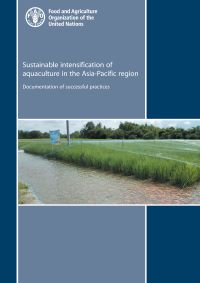Trade, markets and value chain management for the sustainable intensification of Asian aquaculture
4 March 2013 | Fahmida Khatun | 3140 views | .mp3 | 7.69 MB | Markets and trade
Bangladesh is a prominent aquaculture producing country in Asia, ranked the thirteenth in 2009 among 34 Asian countries in terms of production. At present Bangladesh contributes 7.92 percent of global shrimp production. It was the world’s sixth largest producer and seventh largest exporter of shrimps in 2011. However, despite strong growth in production in recent years, shrimp farming faces significant challenges at both domestic and international levels. As a shrimp exporting country, key policy priorities for Bangladesh include increased market access, higher value of production and development of the fisheries sector. This paper discusses some of the major features and dynamics of the shrimp aquaculture sector in Bangladesh relating to trade, market and value chain. This will help identify the challenges and opportunities for the development of the sector. Shrimp aquaculture is selected for study because of its importance for export and employment.
Aquaculture shrimp farming in Bangladesh is carried out mostly under extensive conditions, except for a few intensive farms in Cox’s Bazaar. Few inputs and no mechanisation are used in extensive production systems. Over 37 000 farms culture Bagda shrimp (Penaeus monodon) on farms of average size 4.5 ha in brackish water conditions, while there are 105 000 farms cultivating golda freshwater prawn (Macrobrachium rosenbergii), with average size of only 0.28 ha. About 60 hatcheries are in operation.
Under semi-intensive and intensive farming, productivity is twenty to thirty times higher than with extensive farming. Although significant natural resources and abundant workforce give Bangladesh comparative advantage in shrimp production but poor management, lack of infrastructure, unavailability of suitable land, quality food and fertiliser and variable weather conditions constitute factors which combine to keep the productivity low.
According to the Bangladesh Frozen Foods Exporters Association (BFFEA) there are 149 shrimp processing factories located in Khulna, Bagerhat, Satkhira and Chittagong. Of these, 88 are licensed by the government to export and 74 have permits to export to the EU.
Within the fisheries sector, shrimp make the largest contribution in terms of foreign exchange earnings. The contribution of shrimps to total export income from fish and fish products increased to 91.1 percent in 2010 from less than 1 percent in 1972–1973. The European Union (EU), the United States of America (USA) and Japan are the major importers of shrimp from Bangladesh, accounting for more than 95 percent of total fish exports. The shrimp sector thus carries strategic importance for the national economy, with the EU market of particular importance. The value chain for the Bangladesh shrimp sector is described in detail.
Following banks on exports to EU and USA due to non-compliance with sanitary and phytosanitary standards, Bangladesh has invested substantially in improving processes and control systems, and exports to EU have now resumed, thanks to several initiatives to ensure better management for shrimp aquaculture and resource management, policy support and strengthening of the regulatory framework. Nevertheless, implementation remains weak. In order to export shrimp, quality control licenses are issued by the Bangladesh Standards and Testing Institute (BSTI) under provisions of the Bangladesh Environment Act 1992 and the Bangladesh Environmental Regulation 1997. Processing firms are required to complete Initial Environmental Examination before their establishment, and to submit an effluent treatment plan and environment management plan to the Department of Environment to obtain Environmental Clearance Certification.
Shrimp processed for global markets has to comply with the international standards specified by Codex Alimentarius Commission provisions as well as buyer specifications and regulatory requirements of the importing country. Unfortunately, Bangladesh has difficulty in meeting with these standards due to insufficient resources. As in the case for other developing countries, there is inadequate public sector capacity to monitor compliance to the required standards. Also, Bangladeshi plants have insufficient funds to invest in expensive mechanical equipment, fishing boats, quality control measures and training staff, and the capacity to design, implement and monitor quality and safety compliance is also very weak. Thus, while concerns of shrimp importers about quality and safety compliance by Bangladeshi plants are reasonably justified, and in principle conform to the sanitary and phytosanitary (SPS) provisions of the WTO, the underlying causes of the country’s lack of capacity to address buyers’ concerns must also need to be taken into consideration.
In view of the growing importance of shrimp aquaculture the focus should be the overall development through overcoming the constraints identified along the value chain. Efforts should focus on increasing profitability and income from the sector, by: (i) improving governance through proper implementation of institutional policies and rules; (ii) improving access to resources, removing financial and infrastructural bottlenecks; and (iii) enhancing market access through compliance with trade measures and improvement in environmental performance.
Creative Commons Attribution.
